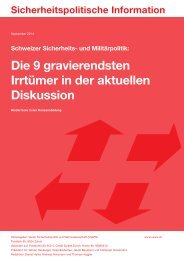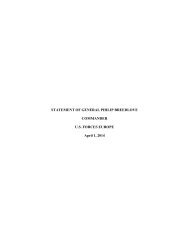FULLTEXT01
FULLTEXT01
FULLTEXT01
Create successful ePaper yourself
Turn your PDF publications into a flip-book with our unique Google optimized e-Paper software.
TACTICAL THOUGHT<br />
2014 September 29 th<br />
This leads to a need to adapt the intelligence function. Different models for focused<br />
analysis are mentioned to facilitate the categorization of Insurgency, such as Dr. John<br />
MacKinlay's model with five different types of insurgencies. 563 Understanding of "the<br />
Human Terrain" is emphasized as a basis for understanding the uprisings 564 . A detailed<br />
description on integrating intelligence with the work in general emphasizes the<br />
importance of the tactical level, time, training and continuity. 565 The importance of<br />
intelligence and having such a capability at the tactical level as the instrument for the<br />
analysis is clear. References to systems thinking are not included.<br />
The concept of centre of gravity (COG) is described as more complex (compared to in<br />
Regular Warfare), but important to use. 566 As an example of an "Operational COG",<br />
"Population optimism about their future” 567 is mentioned. The description of how<br />
insurgents must be understood is characterized by emphasis on adaption of the<br />
intelligence function and work needed to be integrated throughout the whole staff work<br />
structure, and this will be built up over time. Accurate descriptions of how and why this<br />
is required are included. The Intelligence and Security functions and work are<br />
emphasized as an integral part of the entire planning and implementation process, as<br />
well as important for education of officers in general. HUMINT specifically is<br />
mentioned, as well as analysis and research. 568 The intelligence function is placed at the<br />
top of the summary of experience 569 to develop. Intelligence, the intelligence staff,<br />
ISTAR and problem areas have 14 pages devoted to them. 570 . Understanding of "the<br />
Human Terrain" is emphasized as crucial; only understanding the enemy is not viewed<br />
sufficiently. 571<br />
Summary answer U.S. 572 ; descriptions of insurgencies to be analysed and understood<br />
are frequent, down to the company level. 573 Effective analysis is viewed to require<br />
knowledge of the Insurgency strategically, its operational and tactical objectives, which<br />
can be both physical and non-physical. 574 . Descriptions are characterized by pervasive<br />
system thinking. Descriptions of centre of gravity (COG) do not occur (the dictionary<br />
indicates COG as a joint description). The COIN environment is said to consist of a<br />
"system of systems" (inter-connected systems). 575 A clear structure and concept for the<br />
analysis is described. Eight operational variables are used (the so-called PMESII-PT;<br />
the political, military, environment, social, information, infrastructure, physical<br />
environment and time aspects).<br />
563 UK Ministry of Defence, British Army Field Manual, Volume 10, Part 10, Combined Arms<br />
Operations, Countering Insurgency (2009), Annex A to Chapter 2.<br />
564 Ibid. Chapter 3. section 3-12 – 16.<br />
565 Ibid. Chapter 3. section 3-33 – 37.<br />
566 Ibid. Chapter 7. section 7-8 Planning Concept.<br />
567 Ibid. Chapter 7. figure 7-2.<br />
568 Ibid. Chapter 3. section 3-37 and 3-44.<br />
569 Ibid. Chapter 4. section 4-51.<br />
570 Ibid. Chapter 5. section 5-1 – 42.<br />
571 Ibid. Chapter 5. section 5-1.<br />
572 U.S. Department of the Army, Headquarters, Tactics in Counterinsurgency, Field Manual 3-24.2,<br />
April 2009.<br />
573 Ibid. Chapter 2.<br />
574 Ibid. p. 45.<br />
575 Ibid. p. 251.<br />
2





